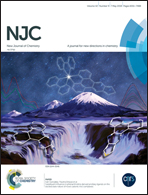Benzo[ghi]perylene and coronene: ratiometric fluorescent probes for the sensing of microenvironment changes and micelle formation in aqueous medium†
Abstract
Benzo[ghi]perylene and coronene were used as ratiometric fluorescent probes to monitor microenvironment changes and monomer-micelle transition for the first time. The perturbations in vibronic bands in the emission spectra of probes displayed microenvironment sensing behavior in various solvents and surfactants. The monomer–micelle transitions of anionic, cationic and neutral surfactants were monitored by changes in the ratios of vibronic band intensities. Clear CMC values were obtained, which is an advantage over the conventional probes such as pyrene with clear CMC values sometimes difficult to obtain due to less steep changes of S-shaped plots. They revealed a redshift in emission which offers a good substitute in situations where the fluorescence of pyrene and the background fluorescence of the assay mixture interfere with each other. BzP exhibited reverse behavior in the perturbations of vibronic band intensities in anionic SDS and SLS relative to cationic and non-ionic surfactants, which was not observed when pyrene was used. In addition, the vibronic band ratios of BzP are thermally more stable than those of pyrene, which is advantageous since strict assay temperature control may not be necessary. These probes are thus helpful for various applications in the areas of sensing and interface science.
![Graphical abstract: Benzo[ghi]perylene and coronene: ratiometric fluorescent probes for the sensing of microenvironment changes and micelle formation in aqueous medium](/en/Image/Get?imageInfo.ImageType=GA&imageInfo.ImageIdentifier.ManuscriptID=C8NJ00739J&imageInfo.ImageIdentifier.Year=2018)


 Please wait while we load your content...
Please wait while we load your content...